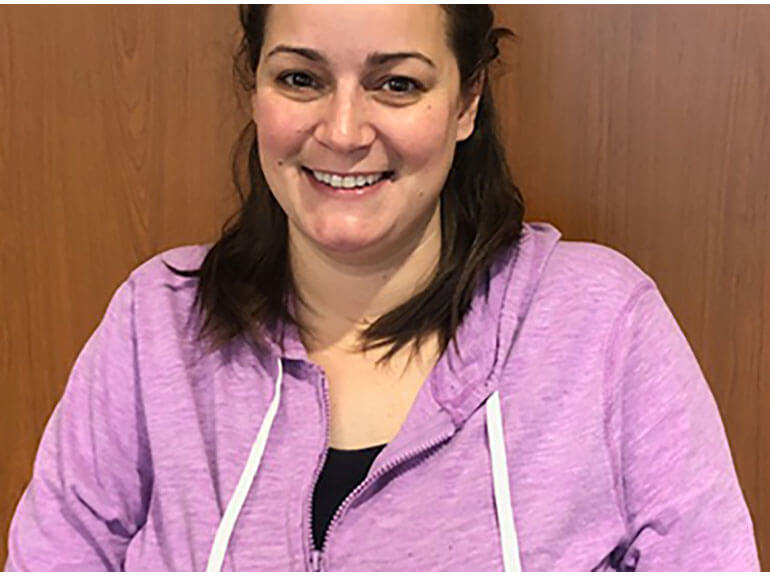Ashley's story

Ashley Harvey leads a very busy life. The 35-year-old is a kindergarten teacher, mother to four young children and wife to husband, Travis. Between her job and running her kids to their various activities, she was always on the go – until an illness changed everything.
In mid-November, Ashley tested positive for COVID-19. For a week, she had a fever, chills and felt rundown. However, by Thanksgiving, she was feeling back to normal and anticipated returning to work the following Monday, but that didn’t happen. She woke up with an intense headache, nausea and tingling in her toes. Over the next few days, the tingling moved into her legs and she developed severe pain in her back and began experiencing muscle weakness. When her symptoms and pain didn’t improve, Ashley asked her mom to take her to the emergency department at a hospital that specialized in neurologic disorders.
After a variety of tests, Ashley was diagnosed with Guillain-Barre syndrome and received treatment to help with the symptoms. She got worse before she got better, and at one point only had function in her wrists and hands.
After a week in the hospital, Ashley was ready for the next step in her recovery and transferred to the TriHealth Rehabilitation Hospital. Upon arrival, she was unable to walk and completely dependent for daily living activities, bed mobility and transferring from one surface to another.
Ashley’s goals were to walk again and be more independent with eating, dressing and going to the bathroom. Returning home to her family was also an important goal and one that kept her motivated. “I will continue to push here each day so that I can get home to my family as soon as possible,” said Ashley. With her goals in mind, Ashley began physical and occupational therapy.
In physical therapy, Ashley began exercises to help with endurance, balance and strength to get her moving and walking again. Early on, Ashley became very tired with any exertion, so she required frequent breaks. Over time, she needed fewer and fewer breaks. Therapists completed manual stretching of Ashley’s leg muscles and had her use a standing frame and parallel bars to promote greater standing tolerance, while allowing her upper extremities to assist with weight acceptance. She was able to progress to standing for seven minutes with the use of a standing frame. She then progressed to standing while shifting her weight from side to side as well as stepping. Gait training activities included walking with a mirror to aide in visual feedback and improve body awareness.
Nearly a month after contracting COVID-19, Ashley was finally able to walk 10 feet with a front wheeled walker and minimum assistance. As Ashley’s sensation returned in her lower extremities, her strength and function soon followed enabling her to walk greater distances with a walker. Therapists also provided training on wheelchair safety, adaptive equipment, body mechanics and fall prevention.
In occupational therapy, Ashley focused on becoming more independent for daily living and self-care tasks, while also managing her pain. Therapists introduced adaptive equipment (reacher, sock aide, long handled sponge) and durable medical equipment to help with these tasks. Each of Ashley’s therapy sessions began with therapeutic conversations and pep talks to help with mental and emotional challenges she faced. To help with core strength and endurance, Ashley participated in upper body strengthening and mat exercises. Over time, as her functional transfers progressed, the team focused on independence with tasks in a seated position and eventually a standing position. As time went on, Ashley’s upper body became stronger and sensation began to return which made completion of daily living tasks easier. In one session right before Christmas, Ashley set herself up to do a Zoom call with her kindergarten class which greatly lifted her spirits.
Ashley’s ah-ha moment was the morning she woke up with knee pain. For most people, that wouldn’t be a good thing. But for Ashley, it meant the feeling was returning to her legs. “Once the pain subsided, I was able to bend my knees and bear weight more comfortably,” said Ashley. “Being able to bend my knees myself was awesome!”
Ashley’s family was also a huge source of support during her recovery. Her husband, Travis, made sure the kids were cared for and happy, making sure they had plenty of FaceTime with their mom. He also attended family training at the hospital so he could help Ashley once she returned home. Texts, calls, e-mails, messages and cards from friends and family also provided encouragement and inspiration. “The last couple of weeks of rehabilitation were the hardest that I’ve gone through in my life,” said Ashley. “But all of the kindness from our friends and neighbors have eased the burden.”
After less than two weeks, Ashley received an early Christmas gift and was able to return home for the holiday having achieved her goals of walking and being independent for daily tasks. Ashley ultimately wanted to get back to the same level of function she had prior to getting sick so she could keep up with her four young children and students. Therapists recommended home health therapy followed by outpatient therapy to continue working on strength and muscle control, with the hope of returning to work soon.
“The progress and changes that I saw in my last week were nothing short of amazing,” said Ashley. “I have no doubt that I will make a full recovery.” Although she knew the hospital would be much quieter than home, she said she was “most looking forward to being home with my family and seeing my kids.”